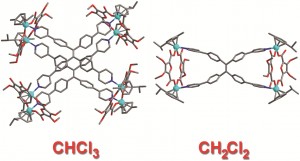It is possible to induce a pronounced structural reorganisation of a metallasupramolecular cage complex with a very conservative change in solvent polarity, say researchers from Switzerland and Turkey.
Solvent-switchable nanostructures reported so far operate via solvent-induced reduction or stabilisation of non-covalent interactions. This cage switches from octanuclear prismatic in chloroform to tetranuclear in dichloromethane. The key to success here is the incorporation of metallacrown recognition units into flexible nanostructures, which allowed generation of solvent specific bonding pockets.
Reference:
A solvent-responsive coordination cage
B Kilbas, S Mirtschin, R Scopelliti and K Severin, Chem. Sci., 2011
DOI: 10.1039/c1sc00779c











